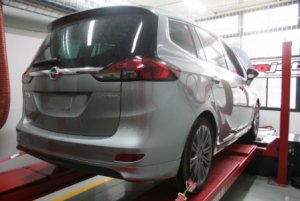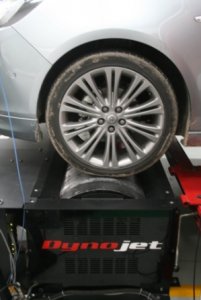2012 ECOTEC 1.4L TURBO (LUJ)
Vehicle Applications
Chevrolet Cruze
Astra J
Meriva B
Insignia
Zafira C
INFO :
Wie die Kurbelwelle sollen die Pleuel und Kolben die größere Belastung durch die Turbo-System aushalten. Die Pleuel sind aus geschmiedetem Stahl und der leichte, übereutektischem Kolben mit einem dickeren Feuerstegbereich und eine einzigartigem Ring-Pack durch das Turbo-System erzeugten Ladedruck zu widerstehen. Das Motorkompressionsverhältnis ist 9,5. Die verstärkte Kurbelwelle und stärkere Pleuel sind einzigartig und liefern zusätzliche die erforderliche Stärke und Kraft, um den unter Druck stehenden Brennraum .. die Motorleistung und Drehmoment über ein breites u/min-Band zu erlangen .
Also ... NIX mit Knickpleulen !
mfg ASH@IPF-TUNING
Hier der Originaltext von GM Powertrain !
Product Highlights
• Dual overhead camshafts with variable valve timing
• Low-mass hollow-cast iron engine block
• Integrated turbocharger and exhaust manifold
• Variable-flow oil pump
• Electronically controlled thermostat
Overview
The turbocharged Ecotec 1.4L is part of GM’s new generation of small-displacement, power-dense four-cylinder engines. It is standard on Cruze ECO, LT and LTZ models; and with its standard six-speed manual transmission, the ECO model achieves an EPA-estimated 42 mpg on the highway – the best non-hybrid fuel economy in the compact segment.
The Ecotec 1.4L turbo’s power ratings are estimated at 138 horsepower (103 kW) and 148 lb.-ft. of torque (200 Nm) between 1,850 and 4,900 rpm. The wide rpm range for maximum torque – a specific trait of turbocharged engines – helps the engine deliver better driving experience and performance.
This turbocharged engine’s power-boosting advantage comes from forcing greater airflow into the engine. Its pressurized charge packs more air into the cylinders, allowing them to process the air and fuel of a larger engine for momentary driving situations.
The Ecotec 1.4L turbo also features premium design elements that give it world-class smoothness and durability, including:
• Low-mass hollow-frame cast iron block
• Dual overhead camshafts with variable valve timing
• Chain-driven cams
• Roller-finger camshaft followers
• Piston-cooling oil jets and integrated oil cooler
• Variable-flow oil pump
• Electronically controlled thermostat
The 1.4L’s turbocharger is integrated within the exhaust manifold, for reduced weight and greater packaging flexibility in smaller vehicles such as the Cruze. The engine incorporates numerous mass-reducing features, including a cast iron block with a hollow frame structure, hollow-cast camshafts and a plastic intake manifold.
Cylinder Block
The Ecotec 1.4L turbo’s cylinder block is made of strong gray cast iron, with five reinforced main bearings. The block offers excellent thermal properties that suit the cylinder pressure and loads generated by a turbocharger system. To minimize weight, it features hollow-frame construction, making it about 20 percent lighter than a conventional casting. The block also incorporates a gray cast iron bedplate that helps reduce engine vibration.
The cylinders within the block are triple-honed for a smoother finish that minimizes piston friction and overall wear, while also optimizing oil and fuel consumption.
Rotating Assembly
With a reinforced, solid-cast crankshaft, the Ecotec 1.4L offers greater strength and stiffness, particularly at higher rpm, to support the boosted cylinder pressure of the turbo system.
Like the crankshaft, the connecting rods and pistons are designed to support the greater load of the turbo system. The connecting rods are forged steel and the lightweight, hypereutectic pistons are designed with a thicker crown area and a unique ring pack to withstand the boost pressure and heat generated by the turbo system. The engine’s compression ratio is 9.5:1.
The reinforced crankshaft and stronger connecting rods are unique, delivering additional strength to support the engine’s pressurized power and torque over a wide rpm band.
Variable-Flow Oil Pump
The Ecotec 1.4L turbo uses a unique variable-flow oiling system that helps maximize fuel efficiency. Rather than the linear operation of a conventional fixed-flow pump, it is accomplished with a crankshaft-driven oil pump that matches the oil supply to the engine load. The Ecotec 1.4L turbo’s variable-flow pump changes its capacity based on the engine’s demand for oil. This prevents using energy to pump oil that is not required for proper engine operation.
Piston-Cooling Oil Jets
The Ecotec 1.4L turbo incorporates piston-cooling oil jets to minimize piston temperatures, which helps optimize performance, efficiency and emissions. Mounted at the bottom of each cylinder, the jets are part of the engine’s oiling circuit and spray engine oil at the bottom of the pistons.
Oil-Water Cooler
The Ecotec 1.4L turbo requires an engine oil cooler to maintain optimum oil temperatures. It has a heat exchanger incorporated into the oil filter housing. Coolant to the heat exchanger is provided by the engine’s coolant circuit. The design optimizes oil cooling with a minimal pressure loss. During the cold starting, the system also enables faster heating of the engine oil for an earlier reduction of internal engine friction.
Structural Oil Pan
An aluminum oil pan is designed as a key structural component of the engine, adding stiffness that helps improve vibration characteristics.
Cylinder Head
An aluminum cylinder head with dual-overhead camshafts and four valves per cylinder is used on the Ecotec 1.4L turbo. The head’s intake port design optimizes performance, efficiency and emissions by promoting greater charge motion of the intake air and a more complete burn of the air/fuel mixture. Sodium-filled exhaust valves are designed for the higher combustion temperatures of the turbo system.
Variable Valve Timing
The dual-overhead camshaft arrangement of the engine employs dual, continuously variable cam phasing to adjust the engine valves' opening and closing timing for optimal performance, fuel efficiency and emissions across the rpm band – including greater low-rpm torque. The intake and exhaust cams can be phased up to 60 crankshaft degrees. Cam phasing also eliminates the need for a conventional EGR by optimizing the amount of exhaust gas in the combustion chamber. A vane-type camshaft phaser with an integrated oil-control valve is used for lower weight and greater packaging flexibility.
Hollow-Cast and Chain-Driven Camshafts
The camshafts in the Ecotec 1.4L turbo are hollow and lighter than conventional solid shafts. Along with reducing the overall weight of the engine, they lower the inertia of the valvetrain and allow the engine to rev higher and more quickly. The camshafts are driven by durable chains.
Roller-Finger Camshaft Followers
A low-mass DOHC roller-finger camshaft follower is used to minimize friction and maintenance. It operates with very low frictional losses, helping enhance efficiency and lower emissions. The hydraulic lash adjusters and the chain cam drive require no maintenance during the life of the engine.
Integrated Turbocharger and Exhaust Manifold
In addition to fuel efficiency, the Ecotec 1.4L turbo delivers exceptional performance density of nearly 100 horsepower per liter. For lower weight, quicker throttle response and easier packaging in the vehicle, the Ecotec 1.4L turbo uses a unique, integrated turbocharger and exhaust manifold. The turbocharger size was chosen with an emphasis on low speed torque and throttle response.
Typically, turbochargers are mounted at the outlet of the exhaust manifold or farther downstream in the exhaust system, but this design incorporates the turbocharger's turbine housing into the exhaust manifold as a single component. It requires fewer parts, is lighter than a conventional system, helps lower engine compartment temperatures and helps the engine warm up faster. The faster warm-up benefits emissions performance, as it enables a close-coupled catalytic converter that promotes a quick “light off.”
The turbocharger is lubricated by engine oil and is liquid cooled for long-term reliability. The pressurized air charge is cooled via an air-to-air intercooling system prior to entering the engine. This lowers the temperature of the inlet air for more a more effective boost charge.
Electronically Controlled Thermostat
The coolant thermostat’s operating point is electronically controlled to optimize engine temperatures during different phases of operation to enhance fuel efficiency. The engine control module monitors sensors and controls the thermostat based on mapping that takes into account the wide range of engine operating conditions, including temperature and load.
# # #



